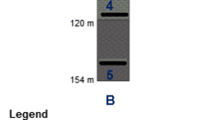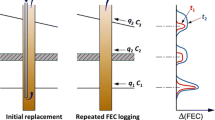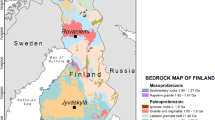Abstract
This paper discusses a new procedure for calculating the conductivity and volumetric heat capacity of drill cuttings from boreholes, an important factor when designing shallow geothermal systems. The experiment in question consists of placing 55–65 kg drill cutting samples inside a container, along with a heat source (point source assumed), and arranging temperature sensors, connected to a data logger, at known distances from the source. A mathematical method for determining the conductivity and volumetric heat capacity associated with this experiment is described.
Similar content being viewed by others
References
Horai K., Simmons G.: Thermal conductivity of rock-forming minerals. Earth Planet. Sci. Lett. 6, 359–368 (1969)
MidttØmme K., Roalset E., Aagaard P.: Thermal conductivities of argillaceous sediments. Geol. Soc. Lond. Eng. Geol. Special Publ. 12, 355–363 (1997)
Brigaud F., Chapman D.S., Le Douaran S.: Estimating thermal. Conduct. Sediment. Basins Using Lithol. Data Geophys. Well Logs 74, 1459–1477 (1990)
J.A. Shonder, J.V. Beck, A new method to determine the thermal propierties of soil formations from in situ field tests. Avalaible from http://www.osti.gov/bridge (2000)
Alonso-Sánchez T., Rey-Ronco M.A., Carnero-Rodríguez F.J., Castro-García M.P.: Determining ground thermal properties using logs and thermal drill cutting analysis. First relationship with thermal response test in principality of Asturias, Spain. Appl. Therm. Eng. 37, 226–234 (2012)
N.K. Jain, Thesis: Parameter Estimation of Ground Thermal Properties. (Oklahoma State University, Stillwater, 1999)
Carslaw H.S, Jaeger J.C.: Conduction of heat in solids. Claremore Press, Oxford (1947)
Ingersoll L.R., Zobel O.J., Ingersoll A.C.: Heat conduction with engineering and geological application. McGraw-Hill, New York (1948)
Deerman J.D., Kavanaugh S.P.: Simulation of vertical U-tube ground-coupled heat pump systems using the cylindrical heat source solution. ASHRAE Trans. 97, 287–295 (1991)
P. Eskilson. Thesis: Thermal Analysis of Heat Extraction Boreholes (Department of Mathematical Physics, University of Lund, Sweden, 1987)
G. Hellström, B. Sanner. PC-programs and Modelling for Borehole Heat Exchanger Design. (International Geothermal Days Germany, Bad Urach, 2001)
T. Austin. Thesis: Development of an In Situ System for Measuring Ground Thermal Properties, Masters Thesis, (Oklahoma State University, Stillwater, Oklahoma, 1998)
Author information
Authors and Affiliations
Corresponding author
Rights and permissions
About this article
Cite this article
Rey-Ronco, M.A., Alonso-Sánchez, T., Coppen-Rodríguez, J. et al. A thermal model and experimental procedure for a point-source approach to determining the thermal properties of drill cuttings. J Math Chem 51, 1139–1152 (2013). https://doi.org/10.1007/s10910-012-0097-4
Received:
Accepted:
Published:
Issue Date:
DOI: https://doi.org/10.1007/s10910-012-0097-4




